Return to the Office


RETURN TO THE OFFICE
With Senior Acoustic Consultant at Hilson Moran - Jack Richardson
and Regional Sales Manager at Armourcoat Surface Finishes - Spencer Drake
Ask anyone 18 months ago to define ‘zoom fatigue’ and frankly who knows what they might have said. A fancy term for jet-lag? Or perhaps what you get after having one too many goes on the infamous office slide at Google’s HQ?
Despite a growing rift between the want-to-go-backs and the want-nots, Quiet Times talks to two experts who can definitely assure us that office life isn’t quite done yet. With 32% of workers expected to attempt to work remotely after the pandemic, according to a recent Deloitte report, we want to explore what beneficial impact to wellbeing and productivity can come from a long-term return to the office. Crucially, how companies can use design innovations to make the office much more appealing to work from than home.
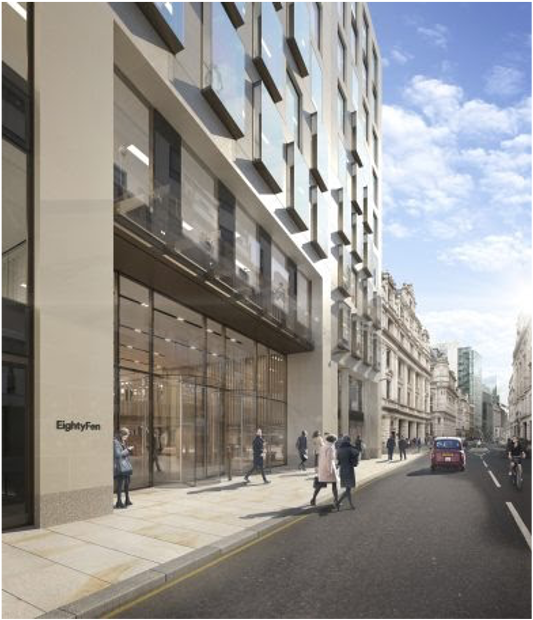 Our guests should have an answer or two. Jack Richardson is responsible for inputting into the design of high performance spaces as a Senior Acoustic Consultant for international multi‑disciplinary engineering practice Hilson Moran. Some of their work includes Shell & Core, Fit Out of the stunning 80 Fenchurch Street, (pictured left), a new landmark 14-storey commercial building located in the heart of London’s evolving city centre comprising 250,000 sq ft of Grade A office floor space for Client YardNine & Partners Group, designed by Architects, Foster and Partners/T.P. Bennett.
Our guests should have an answer or two. Jack Richardson is responsible for inputting into the design of high performance spaces as a Senior Acoustic Consultant for international multi‑disciplinary engineering practice Hilson Moran. Some of their work includes Shell & Core, Fit Out of the stunning 80 Fenchurch Street, (pictured left), a new landmark 14-storey commercial building located in the heart of London’s evolving city centre comprising 250,000 sq ft of Grade A office floor space for Client YardNine & Partners Group, designed by Architects, Foster and Partners/T.P. Bennett.
Spencer Drake is a Sales Manager for Armourcoat Acoustic® whose Quiet Mark certified Plaster System is designed to optimise the acoustics of interior spaces,and can be found inside some of the most iconic buildings on London’s skyline — The Walkie Talkie, The Gherkin, as well as The Shard.
Acknowledging that recently many had no choice but to work from home, Jack starts us off, about the long-term suitability of our rather hastily found workspaces.
“From an acoustics perspective we don’t really design homes to be worked in. It’s normally an additional extra. Employers want to know their employees are in an environment that allows them to be as productive as an office base would be”.
During the lockdown our ears experienced a ‘reset’ as we began to reflect more. We heard more natural things thanks to reductions in air-traffic, road-traffic, and construction noise. In their wake we heard the sounds of nature, and whether experienced from indoors or going outdoors, they’ve calmed us and helped us to feel well.
That word ‘WELL’ is actually a certified mark of the IWBI, International Well Building Institute. Just as Quiet Mark certifies the quietest products, appliances and building materials, WELL certify and verify spaces that satisfy an intense list of thresholds around air quality, light quality, thermal quality and acoustic quality.
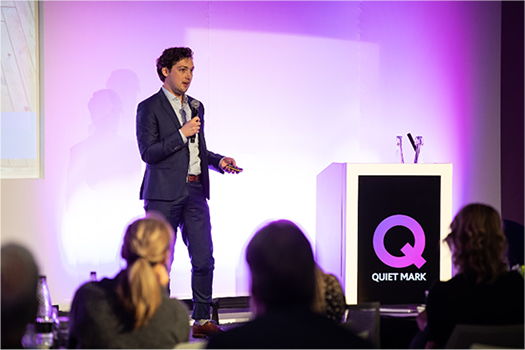 In fact, in order to get that WELL badge, it’s the list of acoustic criteria that is longer than any other. Another pre-condition is that acoustic planning has to be shown as a thought from the outset. So where previously sound might often have been left till last, WELL are certainly intent on making it amongst the first considerations for architects and designers.
In fact, in order to get that WELL badge, it’s the list of acoustic criteria that is longer than any other. Another pre-condition is that acoustic planning has to be shown as a thought from the outset. So where previously sound might often have been left till last, WELL are certainly intent on making it amongst the first considerations for architects and designers.
We’ve previously spoken to Ethan Bordeau, Sound Lead at WELL on Episode 2 of The Quiet Mark Podcast, who also gave a masterclass on the sound-side of WELL certification at our Acoustics Academy launch event last year, (pictured above).
Now in the US, celebrities like Lady Gaga, Jennifer Lopez, Robert De Niro and Michael B. Jordan are rushing to endorse the WELL mark in a Spike Lee directed commercial. The seal is only given to buildings that “have met rigorous scientific standards” so people can feel more “confident going inside”.

Uniting WELL and Quiet Mark’s missions to elevate well-being through improved acoustic comfort in the built environment, CMO and Host of The Quiet Podcast, Simon Gosling, has recently been appointed to WELL’s Home and Sound Advisories. Advisories help shape the evolution of the WELL Building Standard and raise the bar for high-performing buildings and organizations around the world.
Hilson Moran acoustician Jack Richardson is thrilled that sound has been brought up the pecking order. Trained as a musician in earlier life, Jack’s performances in various rooms triggered an awakening, realising that acoustics have a bearing on our emotional response.
“Designing with your ears is as important as designing with your eyes. Without proper attention you end up with a cacophony of noises. It ends up being quite unpleasant. [Often] the aesthetic intention is to have hard, reflective, marble, stone, monolithic finishes. We can build a computer model and then simulate how the sound will behave in that room.
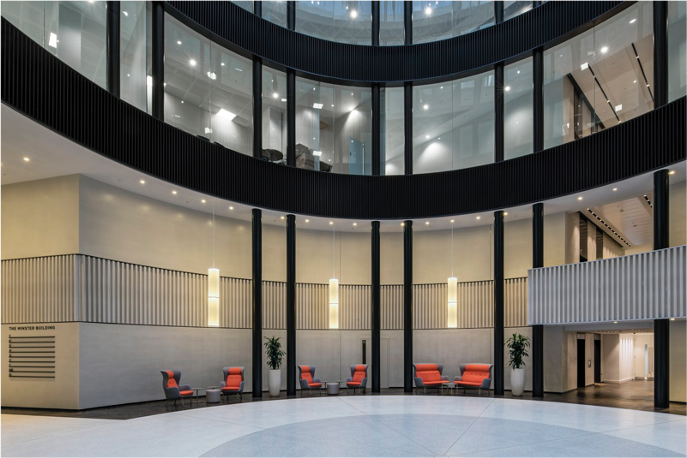 This is where Spencer’s expertise and the Armourcoat Acoustic® plaster system come in. “We’ve had some monolithic parts being up to 200m2 in size.” He takes us through their fit-out of the Minster Building in London, (pictured right), describing the sensation of stepping off a busy London street into a comparative oasis of calm. Armourcoat achieved this despite an enormous, tall circular atrium comprised of reflective surfaces like terrazzo and glass.
This is where Spencer’s expertise and the Armourcoat Acoustic® plaster system come in. “We’ve had some monolithic parts being up to 200m2 in size.” He takes us through their fit-out of the Minster Building in London, (pictured right), describing the sensation of stepping off a busy London street into a comparative oasis of calm. Armourcoat achieved this despite an enormous, tall circular atrium comprised of reflective surfaces like terrazzo and glass.
“We’ve just handled a retro-fit with Hilson Moran of a building with a known acoustic problem. It was therefore possible to get a before and after — that’s actually very rare. With new builds you’re very much reliant on other’s data… it’s lovely to have some raw data to be fed back to our acousticians”.
Armourcoat Acoustic® is a plaster system which can be bonded to ceiling or even walls. As a seamless plaster, it’s mixed with marble aggregate giving it a porous quality which better absorbs sound.
You can find innovations to potentially revolutionise sound in office spaces via our Acoustics Academy. It’s a verified product directory, available to all, filled with ways the building sector can improve the acoustic quality of any building.
As Spencer proudly tells us, now architects can have their cake and eat it too. “Previously you couldn’t mix aesthetics with function, but with the advent of these finishes, you really can.”
Moving off the ground floor — what about the debate back and forth between designing for open plan versus more modular ‘pods'? “Traditionally, pods are almost reverb chambers!” they both decry. It’s a relief to hear that despite the covid requirements, neither reckon we’re about to return to work only to be re-isolated into lonely rooms or pods.
“People are craving a bit of sound from their colleagues, dare I say it!” laughs Spencer. It’s the “little nods, nudges, background feedback you get from working together, or overhearing a telephone conversation… these are all subliminal things that are going in, that you just don’t get when you’re working in a box”.
Of course in designing these spaces, it’s not always about dampening sound. A number of factors can be considered — background noise, speech privacy, reverberation time, sound masking, and impact noise management. Different users will have different needs. A law firm might almost certainly prioritise speech privacy, over all other factors, for instance.
Down the corridor to those breakout spaces… what about collaboration zones in offices — where people congregate to participate in Zoom-busting activities like creative sessions or brainstorming — are these most likely to see most rapid improvement? “Decision making is very difficult over zoom. You don’t get nods of agreement. Some real focus and money will be spent on creating really decent meeting spaces.” thinks Spencer.
Another idea is to get as much WELL accredited space as possible. “WELL accreditation is really good.” starts Jack. “To get on to that scheme, it will offer that benefit… to encourage people to come out of their homes.” Hilson Moran first took the ‘WELL’ leap when refitting their Manchester office, becoming one of the first UK buildings to gain accreditation. So, how does Jack think it feels?
“It’s hard to describe… It makes you feel a lot happier, a lot more alert, stressful situations don’t seem to bother you as much. I’m not based out of the Manchester office, but I wish I was!”
So if WELL accreditation becomes the norm, what will become of the shiny once-atrium-filling Google slides of yesterday? Is it out with the zany and in with the considered? Spencer hopes so. “Anything that can be done from an acoustics perspective, to calm that environment, create the right mood and ambience, and morale, is very important.”
A topic to which Jack re-introduces us, is biophilic acoustics, (one we’ve discussed in detail with Biophilic Design Expert and BBC DIY SOS team-member, Oliver Heath in Ep. 3 of The Quiet Mark Podcast). He feels that in acoustics, there can often be a negative tone, an almost overzealous focus on always what has to be removed. Could we instead try to inject some of that natural calm into the mix — that same calm we innately sought during lockdown?
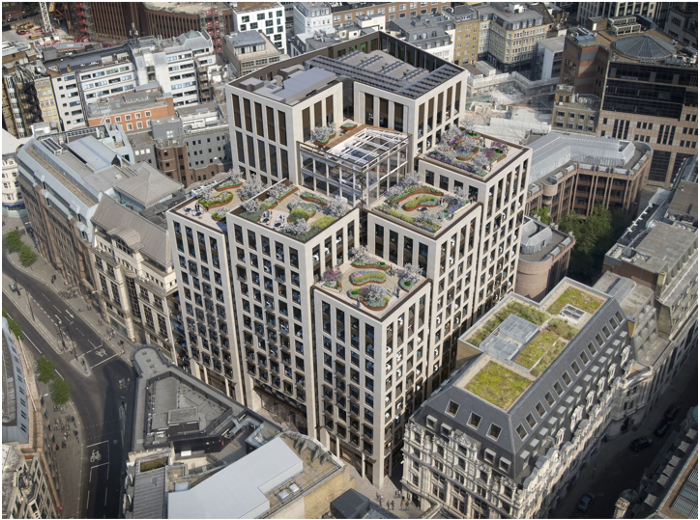 “We have experts in biophilic design in-house, using materials like cork. That has an absorptive property, so it sort of fulfils two functions at once”. Yet more can be done to focus on biophilic sound in particular. “Using water for relaxation, natural sounds… the University of Cumbria have provided research that backs that up. It’d be great to see that concept brought into the workspace.”
“We have experts in biophilic design in-house, using materials like cork. That has an absorptive property, so it sort of fulfils two functions at once”. Yet more can be done to focus on biophilic sound in particular. “Using water for relaxation, natural sounds… the University of Cumbria have provided research that backs that up. It’d be great to see that concept brought into the workspace.”
If the client intention is there — “there’s nothing stopping us now from having audio live-streamed from somewhere around the world, [from another] natural noise-climate, straight into someone’s workspace. As long as that’s considered… the sky’s the limit.”
The next office building you step into might not be beaming audio live from around the globe just yet, but the chances are that if it’s been designed for high performance, sound will have been prioritised. Indeed, the acoustics of our workspaces have well and truly moved up the design food chain, as it’s now seen as one of the most crucial factors to maintaining employee health, wellbeing and productivity.
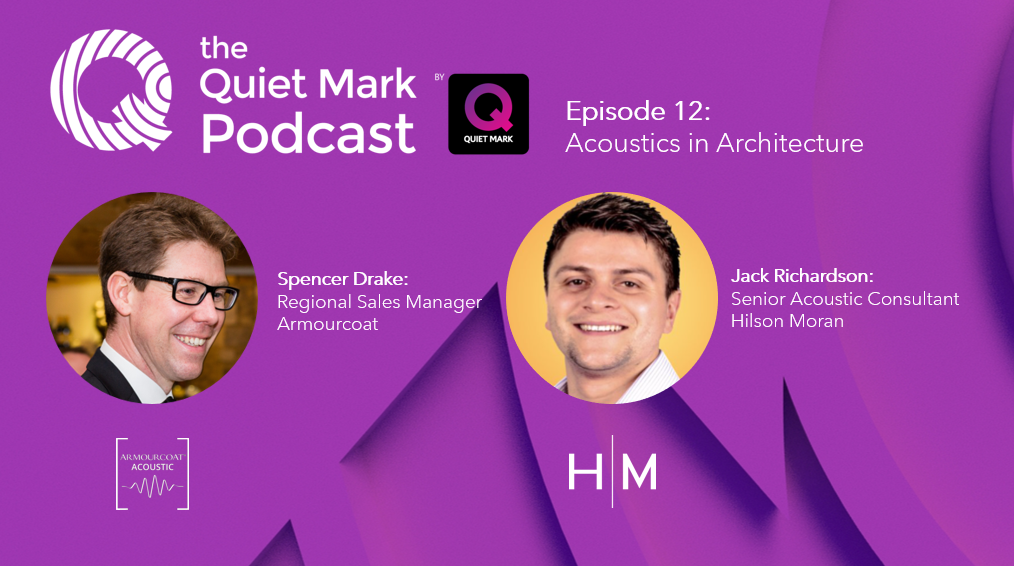
Listen to Jack & Spencer discuss more about ‘Return to Work’, and their roles, on The Quiet Mark Podcast
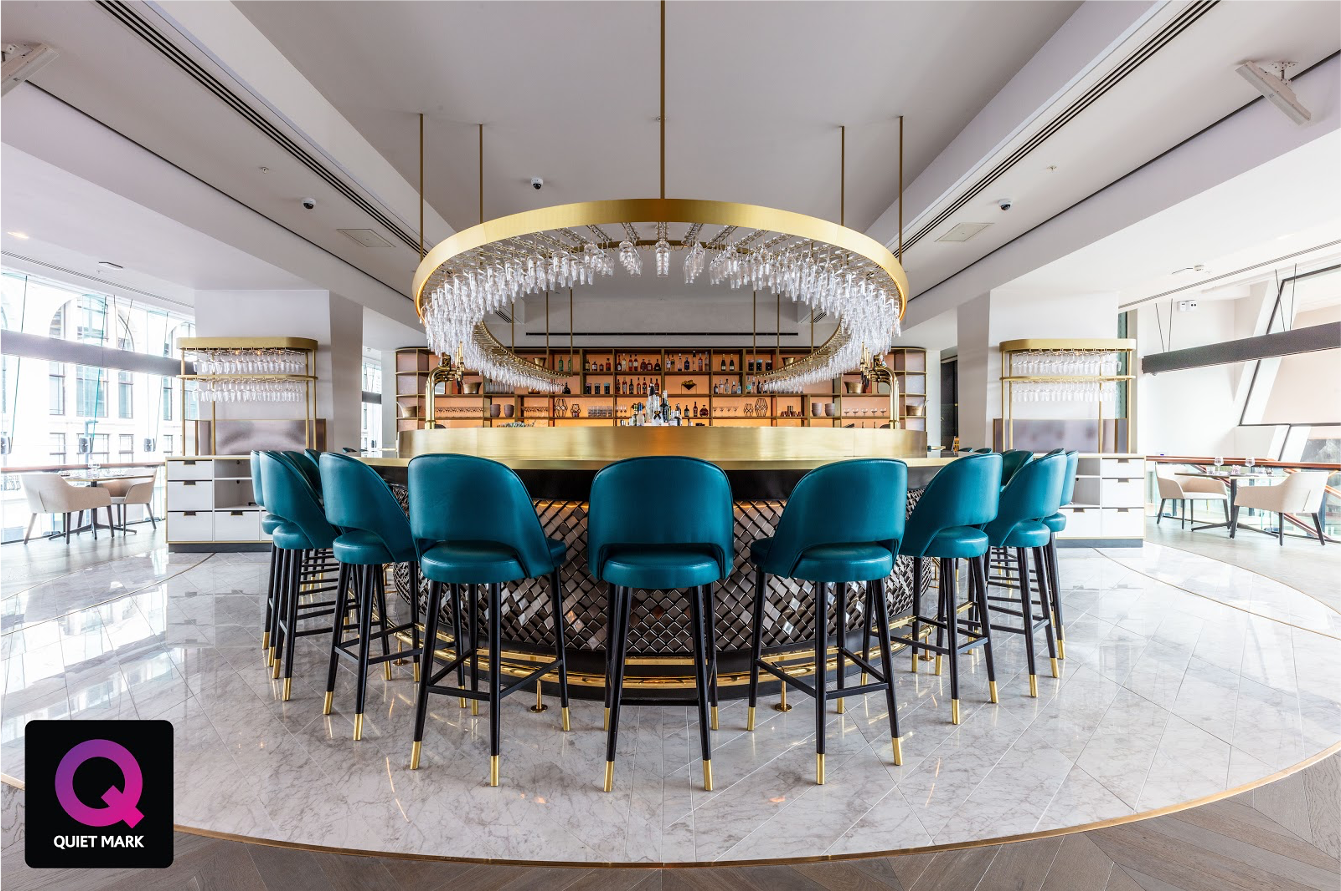
Learn more about Armourcoat Acoustic® HERE
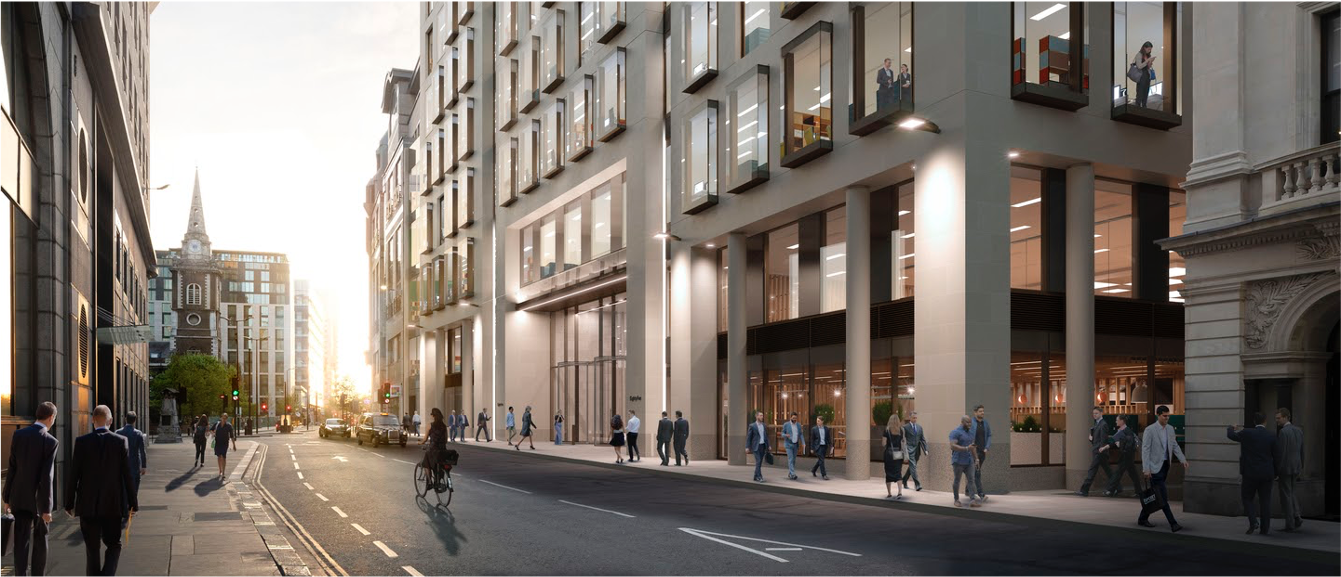
Find our more about Hilson Moran’s work on 80 Fenchurch Street HERE.

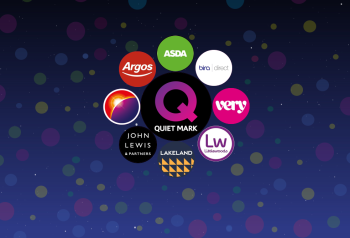



 Quiet Mark Founder
Quiet Mark Founder